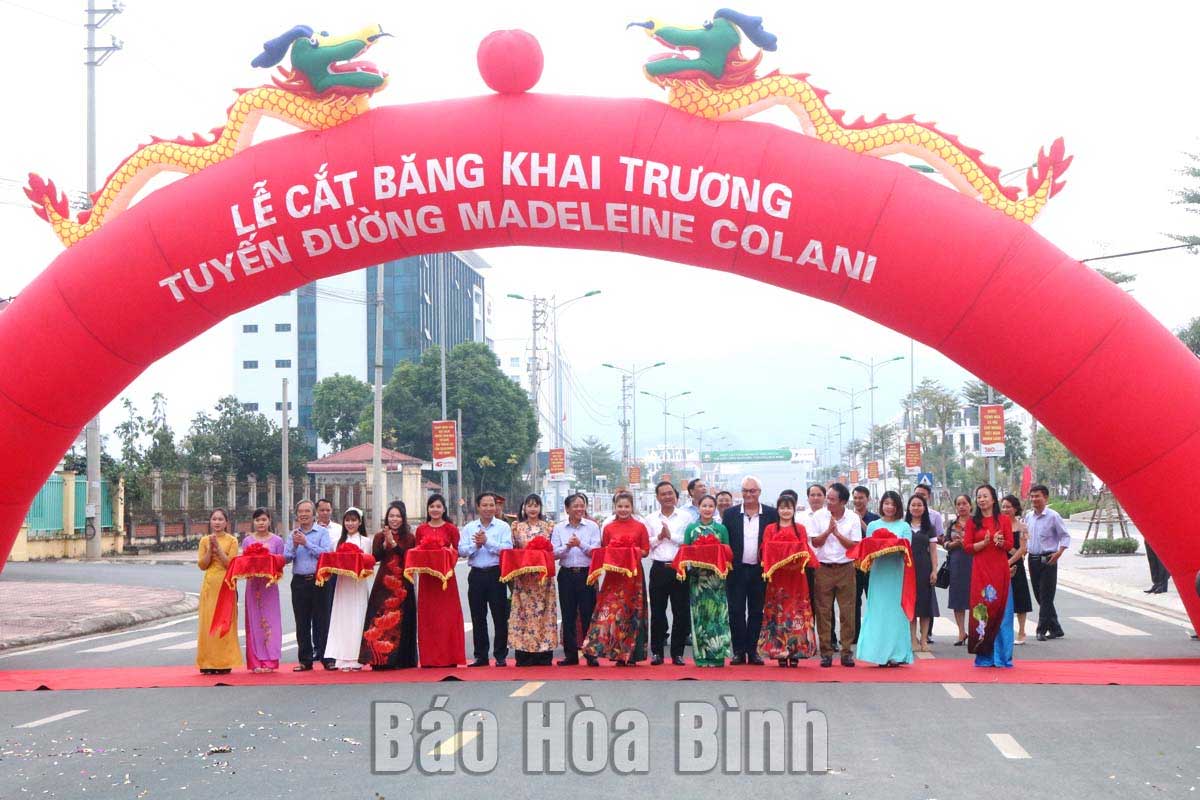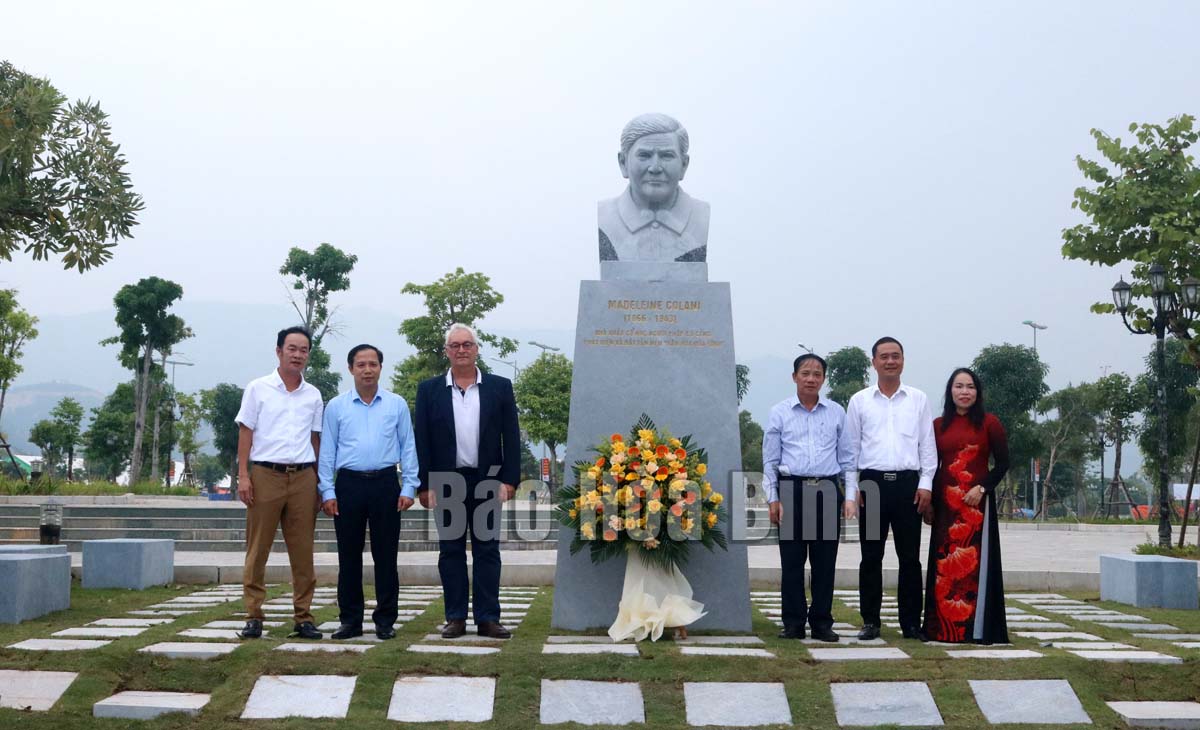
(HBO) - In the afternoon of November 22, the People's Committee of Hoa Binh City held a ribbon-cutting ceremony to open the route named after French archaeologist - Ms. Madeleine Colani. Mr. Van Khanh, the Deputy Secretary of the Provincial Party Committee, the Chairman of the Provincial People's Committee, Mr. Nguyen Van Toan, the Vice Chairman of the Provincial People's Committee. Dr. Philippe LE FAILLER, the Chief Representative of the Institute of the French Far East in Vietnam attended the ceremony.
Mr. Bui Van Khanh, the Deputy Secretary of the Provincial Party Committee, the Chairman of the Provincial People's Committee and the delegates were cutting the ribbon to inaugurate the route named after French archaeologist - Ms. Madeleine Colani.
The archaeologist, Madeleine Colani, was born in 1866, is a geologist, a paleontologist and an archaeologist, who has made great contributions to the formation and development of Vietnam's archeology in particular and Indochina archeology in general. From 1926 to 1932, her survey space was the limestone mountains of Hoa Binh, Ninh Binh, Thanh Hoa, Quang Binh provinces. Ms. M. Colani discovered and excavated 54 Hoa Binh cultural sites in the North of Vietnam, in which most of the sites are located in Hoa Binh province… Ms. M. Colani is the person who has pioneered in discovering and researching "Hoa Binh Culture”.
Mr. Bui Van Khanh, the Deputy Secretary of the Provincial Party Committee, the Chairman of the Provincial People's Committee, Mr. Nguyen Van Toan, the Vice Chairman of the Provincial People's Committee and other delegates took photos at the bas-relief of the French archaeologist, Ms. Madeleine Colani.
Route QH7 is 450m long, 35m wide, the first point is adjacent to the roundabout at Hoa Binh Square; the end point is adjacent to QH8 road, Quynh Lam ward (Hoa Binh city). This is a work to celebrate the 90th anniversary of the world's recognition of "Hoa Binh Culture” (1932 - 2022), with a view to propagating, promoting, introducing and honoring the unique archeological cultural values of the world-famous stone age culture in Hoa Binh homeland. It was to honor the contributions of Mrs. M. Colani who had the merit of discovering and naming " Hoa Binh culture:...
At the ceremony, the delegates reviewed the meaning and historical value of Hoa Binh Culture and the contribution of Ms. M.Colani; cutting the ribbon to open the route named after the French archaeologist; visiting the route and bas-relief of the French archaeologist - Mrs. M. Colani.
Hoa Binh province is undergoing a dynamic transformation amid Vietnam’s national digital transition. Building on Poliburo’s Resolution No. 57-NQ/TW on breakthroughs in science, technology, innovation, and national digital transformation, the province has rolled out a wide range of practical action plans. A standout initiative is the "Digital Literacy for All” movement, an effort to ensure that no one is left behind in the digital era.
Hoa Binh province is undergoing a dynamic transformation in the wake of the national digital transformation movement. Building on Resolution No. 57-NQ/TW of the Politburo on breakthroughs in science, technology, innovation, and national digital transformation, the province has implemented a wide range of practical action plans. A standout initiative is the "Digital Literacy for All” movement ambitious effort to ensure that no one is left behind in the digital age.
With a spirit of unity and proactive problem-solving, the Party Committee, the government and the people of Dong Lai Commune (Tan Lac District) have made great strides in implementing the resolutions of the 24th Party Congress of the commune for the 2020 - 2025 term. Focusing on leadership and practical actions, the commune has brought the Party’s resolutions into daily life, creating strong impacts and pushing the local development forward.
Amid the nationwide push for digital transformation, young people in Hoa Binh Province are stepping up as dynamic pioneers, applying technology to enhance Youth Union operations and expand the reach of youth-led initiatives. Through creativity and adaptability, Youth Union organizations at all levels have introduced a series of practical solutions, contributing to modern governance and community development.
In recent years, An Nghia commune, located in Lac Son district, has stepped up administrative reform, focusing on improving the quality and efficiency of its single-window service unit for receiving and processing administrative procedures. These improvements have helped create favourable conditions for local residents and organisations to handle administrative procedures, contributing to the commune’s broader socio-economic development.
The Prime Minister-approved master plan to develop the multi-use value of forests ecosystems through 2030, with a vision to 2050, aims to improve the management and sustainable use of forest resources, create jobs, increase incomes, and improve the living standards of ethnic minorities, people in mountainous and remote areas, forest workers and those living near forests.




